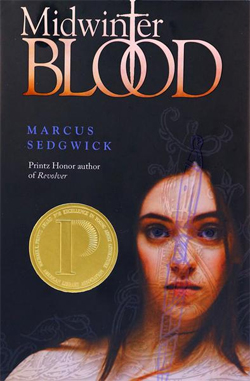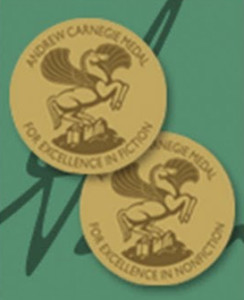
After 40 years of the Booklist Books for Youth Forum, it was time for a transition. On Friday, June 27, Booklist and the Young Adult Library Services Association (YALSA) partnered to present the Michael L. Printz Program and Reception.
YALSA President Shannon Peterson introduced this year’s Honor Books—Eleanor and Park by Rainbow Rowell, Kingdom of Little Wounds by Susann Cokal, Maggot Moon by Sally Gardner, and Navigating Early by Clare Vanderpool—and the 2014 winner Midwinterblood by Marcus Sedgwick.
Sedgwick’s thank you speech kept the audience laughing and applauding, setting the bar and the tone for the evening. He explained that in fact he had very little confidence in his abilities as an author. “Like most writers, I live in a bubble of self-reproach and wanting to murder my inner critic, so thank you for this award because it gives me just a little more confidence,” he said.
After thanking the people who’ve been most influential in relation to his career, including his wife and publisher, Sedgwick commented on the importance of acknowledging that there are many smart, clever adults who do not read simply because that “switch was never flicked.”
“We’ve come to the point again where we’re having the discussion of who reads what, and all I can say is, ‘Who cares?’” he said, referencing recent suggestions that adults who read YA material should be “ashamed of themselves.” “The only thing that matters is that someone is reading, not what they’re reading.”
He went on to talk about the importance of addressing the darker part of life in his stories. Childhood is the formative, shared experience for everyone, he said, and it’s often when people realize that parents or adults may not have all the answers to why there is darkness.
“Children’s books are the most important books. What we read in childhood matters. The novel is the safe place for children to explore the darkness,” he said.
All the authors then answered questions that had been submitted online in advance of the event. They were almost unanimous in saying that when writing, they didn’t think about teens or young adults as their audience—they didn’t really think about the audience at all.
“It’s very frightening thinking of writing for an audience—it’s too many people,” Rowell said. “There is no one joke that will make six people laugh, so I often think of my sister who is very hard to make laugh. But mostly I think about the story I want to tell and the characters’ voices.”
“I think of YA with ‘y’ standing for ‘why?’ and ‘a’ standing for ‘attempted answer.’ Yes, I do know who I write for; it’s me,” said Gardner. The other panelists all agreed.
“I think it’s quite arrogant to try and write for anyone else because you’re assuming what other people want to read,” Sedgwick said.
The writers also discussed how art, music, and literature had influenced them and their writing. Rowell explained that she wanted to capture the feeling of isolation prevalent in Nebraska in the 1980s in Eleanor and Park. “In some ways, music is like seeing land—it tells the characters there is more out here, beyond their bedroom,” she said.
Cokal enjoys projecting the world she’s imagining around her through paintings and sculptures, often of nude women. “All the arts come together because we’re creating a new world, but it has to seem real,” she said.
When asked about the kind of research that goes into their novels, Vanderpool shared a story of trekking the Appalachian Trail with some friends and “immersing ourselves in a lot of serendipity.” “You take it all in, but you don’t know what will make it into the book, even though my friends kept asking me,” she said. “The things you don’t expect pop up in your story.”
Cokal shared that visiting her mother’s native Denmark as a child was very influential in her fascination with fairy tales and watery lands. Speaking to the existence of more fiction based around Scandinavia, she said, “Scandinavia, we’re the new Italy!”
Sedgwick admitted that Midwinterblood was done with almost no research at all, and Rowell said she relied on her memories for most of Eleanor and Park. “I have a pretty good memory for things that are humiliating,” she said.
A teen submitted a question asking what made the writers sad, to which replied, “How long have you got?”
“I’m a writer; everything makes me sad. Old people, young people, babies, a child dropping their ice cream. This is why we write, to get rid of the sadness. Because things are sad but also beautiful,” he said.
Continuing the theme of children, Gardner said, “Children often get overlooked, not understood. We’re all brought up by giants. And that’s what makes me sad. Because we all grow up to be giants.”
For Rowell, a former newspaper reporter, sadness is extremely familiar. Sharing stories of how gut-wrenching it was for her to write every obituary she was assigned, she said, “I found that sustaining sadness was very helpful as a writer.”


